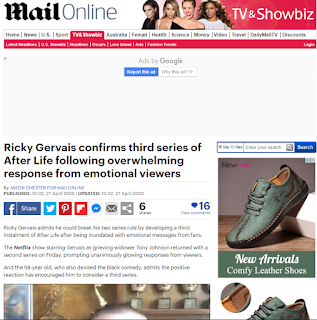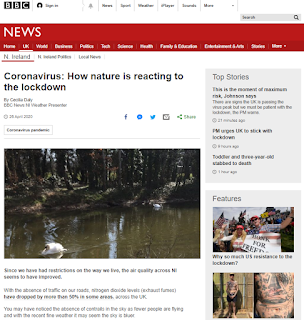1. Channel 4 News - April 20th, 8:00pm to 8.15pm (Freeview Channel 4, Sky Channel 104)
Who's presenting it? -
Jon Snow (+ Cathy Newman)
Do they link to anyone else? -
Someone for the deaf and blind story (missed the name), Siobhan Kennedy & Katie Martin (oil), Cathy Newman in studio introducing some stories
What does the studio look like? -
Purple colour scheme, square imagery on glass behind presenters desk, desk in the middle of room,
(*Currently presenting it (mostly) from home(s) due to Covid-19*)
Is there a title sequence? What happens in it? -
(After ad break) 4 News logo animated into form, couple seconds long, shortened version of their theme
How many stories covered? - ~4
Deaf and blind peoples' struggles during the pandemic - lack of interpreters during UK announcements etc, people with disabilities during Covid, US plunging oil prices, "lock-down art"
How did it end? -
Ad break - read out headline(s) they'll follow up on after break, bit of theme plays
2 - BBC News - April 20th, 10:38am to 11:00am (Freeview Channel 231, Sky Channel 503)
Who's presenting it? - NEVER SAID NAME!!
Middle aged blonde woman
Do they link to anyone else? -
Interviewed Aruna Kashyap & Paul Holmes, John Macquire reports about schools, Carol Kirkwood does weather
What does the studio look like? - Reporter on desk in forefront, red colour scheme, lots of desks and computer screens behind glass pane behind reporter, Large TV to her right
Is there a title sequence? What happens in it? -
(Pre-headlines) Around 20 sec countdown bottom right, BBC News Logo bottom left, clips of England playing in background, red graphics added in randomly
(Post-headlines) Red Earth graphic spinning top right, beepy theme, about 5 secs long, BBC News Logo bottom left
How many stories covered? - ~7
Ruby Prince Cruise ship quarantined and remained docked' (interviewed pianist on the ship - Paul Holmes), Safety Equipment Delays, Experimental Treatment (both mentioned on "Headlines"), US Corona-virus Situation (Trump responding to question about his opinions on protests to the lock-down - is okay with it), Bangladesh clothing industry hit (interviewed Aruna), back to school day (BBC plugged their Bitesize program), weather
How did it end? -
(Ad break -all BBC products) - came right after weather, came back with different presenter
(End) Says that's it, leads into local news
3 - ITV Lunchtime News - April 21st, 1:28pm to 1:47pm (Freeview Channel 3, Sky Channel 103)
Who's presenting it? -
Nina Hossain
Do they link to anyone else? -
Carl Dinnen (lack of protective resources), interviewed Paul Brand (care homes), interviewed Sergei Urban (DadLab)
What does the studio look like? -
Bluey-green colour scheme, presenter in forefront, cubic desk in middle (bluey-green and white), Michael Hadfield (Protools Plastic), screens behind a glass panel behind presenter
Is there a title sequence? What happens in it? -
After a quick run through of the headlines, clips of cities edited into montage to theme, zooms out to put greeny-blue itv News Logo in the centre
How many stories covered? - ~6
Lack of protective resources and gowns during Covid-19, number of deaths in care homes gone up, combating Covid related scams online, MPs return to house of commons, Plastic company increased business cresting pro masks, Homeschooling with 'DadLab'
How did it end? -
(End) Says goodbye, shows zoomed out wide shot of presenter at desk, plays theme for around 4 seconds, graphic of itv news logo
4 - Sky News - April 23rd, 9pm to 9:12pm (Freeview Channel 123, Sky Channel 523)
Who's presenting it? -
Gillian Joseph
Do they link to anyone else? -
Beth Rigby & interviewed Kate McCann (Lock-down releasing), Ed Conway (business decrease), Thomas Moore (vaccine testing)
What does the studio look like? -
Black glass desk in centre for presenter, large square screen behind showing white and blue colours, wooden floor, quite empty, modern, tv screens to left of presenter
Is there a title sequence? What happens in it? -
Sky News logo in centre, graphic opens up to show news story on screen shown in widescreen then in a portrait phone view, graphic closes again to show logo again, opens again into the news
How many stories covered? - ~5
All essential workers eligible for tests starting 24th, death count of Covid in hospitals, possible lock-down removal date, hugest slump in business on record, testing new Covid vaccine on humans begins
How did it end? -
(End) Read some headlines for the next show (due to it being a 24 hour news channel), 'Covid-19 Key Facts' displayed on screen,
News Values:
What is meant by the term news values? -
These are general criteria (or guidelines) which help determine how much 'newsworthiness' a story has or how much prominence a news story deserves from the media outlet. Usually, the more values a story has, the more worthy the story is considered.
What are the 12 categories / values? -
Proximity, Prominence, Currency, Conflict, Timeliness, Impact, Human interest, Consequence, Scandal, Extremes/Superlatives, Bizarreness/Oddity and finally the Facts.
What each value is/includes (with examples) -
Proximity:
If something has/is occurring close by, the impact of it on the audience (especially if it is a local newspaper for example) will be larger than if it was just a general story or one from somewhere else. If something is happening closer to the reader, they will be more interested in hearing about it.
Prominence:
Somebody's name who is well-known to many (like a celebrity, a royal, or any other large public person) will attract more people's attention when they are involved in a story than if the exact same story was about any other unknown person. Well-known people, events, or places possess stronger news angles than ones the general public is not as familiar with.
Currency:
More value comes from a new story when it is a trending story relevant to the public concern, like if it was about the national election or the Olympics, as opposed to ones that only a few will care about. A story's 'currency' relates to popular topics that will spark debate and communication among its readers. Often, news sources will produce stories alongside the main ones to give readers a better understanding of the topic it is about.
Conflict:
Arguments, rivalries and disagreements will always peak interest of audiences and readers - it is human nature. Naturally, people want to choose sides and stand up for whatever that side is that they have chosen or feel as if they relate to more, so it is common for an event that is related to some conflict in any way to be enough to make many interested due to that alone. Specific types of stories that often relate to and involve conflict are often those about religion, business, sport, wars, human rights violations and politics as a whole.
Timeliness:
News that is current or is happening at the time of the story's release has a lot more impact than a piece of news that happened a few days previously. New media loses interest very fast, meaning that events from the past (even if that past is only a couple days prior) can become stale - especially when there is always fresh news popping up elsewhere.
Impact:
The more people involved in a story's events, the better. More people will be interested in an event that involved thousands of strangers than one that just involved a few. Similarly, the higher amount of people who are affected by the event will have the same effect - the more involved in a story, the bigger its newsworthiness becomes. Examples of stories with huge impact like this could include a report of the heightened infected number of Covid-19 patients, or a protest with thousands of participants.
Human Interest:
If some sort of emotional reaction is brought out from a reader/viewer learning about a specific situation, it is very possible that the story contains the news element of a 'human-interest' story. These stories can be gentle. nice ones, like videos of new lambs that have been born at a local zoo, or more infuriating ones of something like the most recent incompetence from a country's government.
Consequence:
If an event reported on can/will impact the readers directly, they will, of course, want to know. For example, a report about a new virus hitting the world and its dangers will have a lot more potential consequence to the reader than a report on a new animal being added to the world's endangered species list.
Scandal:
As much as people don't often like to admit it, almost everyone loves to hate on somebody who did something extremely wrong, partly because they enjoy being on the right side of something. Due to this, reporters always want to be the first to report a new scandal that comes out, but a in order to keep the journalist integrity, the facts must be accurate as to avoid wrongful hate being thrown anywhere and the negative affects that can often cause more so than not.
Extremes/Superlatives:
If a reporter can legitimately claim or prove it to be accurate, their readers will likely be interested in the reporters' most recent find of the longest, biggest, smallest, highest, and so on of something in the world. This does not mean a reporter hyperbolising in their story, but instead that the claims are a hundred percent accurate.
Oddity/Bizarreness:
Sometimes. a story simply being really odd and bizarre can contribute to it being enough to make news out of, sometimes even being enough on its own - the more unusual or shocking something is, the better.
The Facts:
It is always important for a report to come out with all the facts associated. As much as the speed of a story's release can contribute largely to the amount of people who read it, if that story has been rushed out and needs to be updated in the future explaining that some of the facts were mis-reported, it can potentially lead to the trust between the reporter and the audience breaking down, meaning that the reader will be less likely to read that reporter's stories again in the future from fear of it not being true.












No comments:
Post a Comment